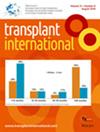Antibody-Mediated Rejection in Liver Transplantation: Immuno-Pathological Characteristics and Long-Term Follow-Up.
IF 2.7
3区 医学
Q1 SURGERY
引用次数: 0
Abstract
The diagnosis of liver antibody-mediated rejection (AMR) is challenging and likely under-recognized. The association of AMR with donor-specific antibodies (DSA), and its clinical course in relation to pathologic findings and treatment are ill defined. We identified cases of liver AMR by following the criteria outlined by the 2016 Banff Working Group. Patient demographics, native liver disease, histopathologic findings, treatment type, clinical outcome, and transaminase levels during AMR diagnosis, treatment, and resolution were determined. Patients (n = 8) with AMR average age was 55.2 years (range: 19-68). Seven of eight cases met the Banff criteria for AMR. Personalized treatment regimens consisted of optimization of immunosuppression, intravenous pulse steroids, plasmapheresis, IVIG, rituximab, and bortezomib. Five patients experienced complete resolution of AMR, return of transaminases to baseline, and decreased DSA at long-term follow-up. One patient developed chronic AMR and two patients required re-transplantation. Follow-up after AMR diagnosis ranged from one to 11 years. Because AMR can present at any time, crossmatch, early biopsy, and routine monitoring of DSA levels should be implemented following transaminase elevation to recognize AMR. Furthermore, treatment should be immediately implemented to reverse AMR and prevent graft failure, chronic damage, re-transplantation, and possibly mortality.肝移植中抗体介导的排斥反应:免疫病理特征与长期随访
肝脏抗体介导的排斥反应(AMR)的诊断具有挑战性,很可能认识不足。AMR与供体特异性抗体(DSA)之间的关联、AMR的临床过程与病理结果和治疗之间的关系尚不明确。我们按照2016年班夫工作组制定的标准确定了肝脏AMR病例。我们确定了患者的人口统计学特征、原发性肝病、组织病理学检查结果、治疗类型、临床结果以及 AMR 诊断、治疗和缓解过程中的转氨酶水平。AMR患者(n = 8)的平均年龄为55.2岁(范围:19-68岁)。8 例中有 7 例符合 AMR 的班夫标准。个性化治疗方案包括优化免疫抑制、静脉注射脉冲类固醇、血浆置换、IVIG、利妥昔单抗和硼替佐米。五名患者在长期随访中,AMR 完全消退,转氨酶恢复到基线水平,DSA 下降。一名患者发展为慢性 AMR,两名患者需要再次移植。确诊 AMR 后的随访时间从 1 年到 11 年不等。由于 AMR 可在任何时间出现,因此在转氨酶升高后应进行交叉配血、早期活检和 DSA 水平的常规监测,以识别 AMR。此外,应立即进行治疗以逆转 AMR,防止移植失败、慢性损伤、再次移植以及可能的死亡。
本文章由计算机程序翻译,如有差异,请以英文原文为准。
求助全文
约1分钟内获得全文
求助全文
来源期刊

Transplant International
医学-外科
CiteScore
4.70
自引率
6.50%
发文量
211
审稿时长
3-8 weeks
期刊介绍:
The aim of the journal is to serve as a forum for the exchange of scientific information in the form of original and high quality papers in the field of transplantation. Clinical and experimental studies, as well as editorials, letters to the editors, and, occasionally, reviews on the biology, physiology, and immunology of transplantation of tissues and organs, are published. Publishing time for the latter is approximately six months, provided major revisions are not needed. The journal is published in yearly volumes, each volume containing twelve issues. Papers submitted to the journal are subject to peer review.
 求助内容:
求助内容: 应助结果提醒方式:
应助结果提醒方式:


